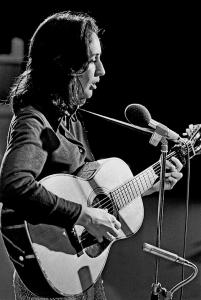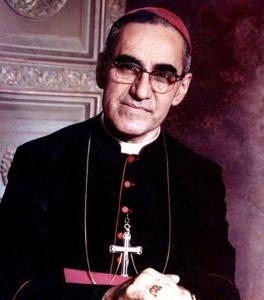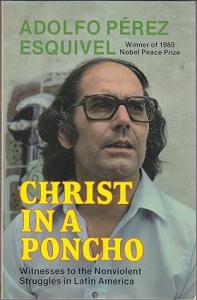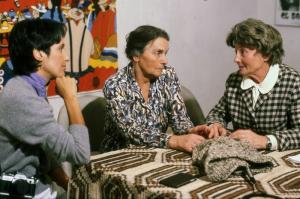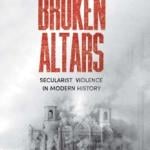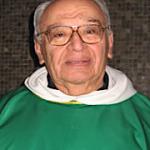Joan Baez is back in the news because of the recent film A Complete Unknown about the life of Bob Dylan. Actress Monica Barbaro’s portrayal of Baez was riveting enough to garner an Oscar nomination. Baez was the folk music world it girl before Dylan came on the music scene, and she used her fame to support both the free speech movement and the civil right movement throughout the 1960s.
I have been researching Baez for a couple of years, especially analyzing her time with Cesar Chavez and the United Farm Workers and her connection to Latino/a and Latin American causes. It is an understudied aspect of her life.
As I begin putting together the finishing touches on my research article, Baez’s words before a concert in the 1980s really stood out:
“I dedicate it to the refugees from El Salvador and Guatemala, and to the Sanctuary movement, the churches and the people who harbor, feed, clothe, and hide the refugees until it is safe for them to return home where most of them want to be.”
If you catch recent interviews with Baez, you will discover that she seems frustrated that the same social-political struggles she spoke out against years ago remain with us today. This particular statement being one such example.
Some might balk at Baez’s words at a concert, perhaps thinking here is another example of a celebrity that is detached from the workings of how the real world operates. However, that is what makes Baez different from the average celebrity. From an early age she was dedicated to spreading the message of peace, mostly supporting nonviolent activist groups already in action.
Baez worked tirelessly to help refugees whether they were fleeing left-wing or right-wing dictatorships, or because of the wayward policies of democratic states. Her belief in human rights and nonviolence were foundational, not political ideology.
Baez worked with or learned from key Christian figures like Martin Luther King Jr., Cesar Chavez, Dorothy Day, and Thomas Merton to name a few famous U.S. Americans. However, Baez’s activist reach was truly global. I teach Christian history classes and one of the key points about Baez’s role in history is how she is often connected to some of the figures and events associated with it from all over the earth because of her steadfast commitment to nonviolence.
For example, it appears that one of the events that motivated Baez to get involved in a human rights campaign in Latin America was the assassination of Archbishop Oscar Romero on March 24, 1980. Evidently, she performed in a memorial service in Washington, D.C. to honor the fallen Salvadoran priest. Romero is considered one of the great peacemakers from Latin America and a modern Christian martyr. He was killed by the military because he spoke against the violence that was destroying the way of life in El Salvador.
In 1974, Baez produced an all Spanish album Gracias a la Vida based on her time with the farm workers and for the social-political troubles in some Latin American countries. This illustrates her growing interest in the plight of disenfranchised farm workers here in the United States but also across Latin America. Many would flee the militaristic, dictatorial violence in countries like Argentina, Chile, Brazil, and El Salvador. Baez decided to visit some of the hot spots in the early 1980s.
The short documentary Joan Baez in Latin America: There but for Fortune was produced to raise awareness of the violence throughout Latin America. This included the disappearance of people because they were perceived to be a threat to their governments. Baez would meet with the human rights activist Adolfo Pérez Esquivel, writer of the Orbis book Christ in a Poncho, who won the Nobel Peace Prize in 1980 and some of the Mothers of Plaza de Mayo (Mothers of the Disappeared). One of the directors, Julio Emilio Moliné, provides some interesting insights about Baez’s visit in the early 1980s.
It is amazing they were able to shoot any film on Baez’s visit considering that most of her concerts were cancelled by the dictatorial regimes and she had to deal with bomb and death threats. Much of her singing is done in smaller venues since she was under constant surveillance and dealing with many credible death threats. She was witnessing egregious censorship firsthand. This was frustrating for Baez since she went to these countries to sing! However, Baez was able to still inspire a little bit of hope in what seemed like a hopeless situation. Moliné reveals that in Chile Baez was able to hold an impromptu concert at a church building , singing for the victims, with a banner dedicated to Oscar Romero behind her with the words: “Nadie muere para siempre” (No one dies forever). Decades later, Baez would eventually later return to do a tour of Latin American countries.
The online editions of the documentary are not the best quality, but if you are interested in this time in history, I would recommend giving it a watch. For its time, the idea was many U.S. Americans were unaware of the dirty wars, disappeared people, and dictatorships across Latin America. The documentary was made to raise awareness. My sense is that the same lack of knowledge about neighboring nation-states still holds true.
The title of the documentary There But a Fortune was from a song written by folk singer Peter Ochs. It’s haunting words relate to the social-political problems of the 1960s but its almost providential tone allows the song to be utilized as a theme for Baez’s visit to Latin America. As noted, Baez’s time in Latin America is not a well studied part of her life. This is ironic since she is Mexican American. I am hoping more scholarship will be written about her soon that does justice to all of her work across the globe.
Joan Baez is much bigger than just being a folk singer or part of Dylan’s biography. She is a legend in peacemaking. In most of the major nonviolent movements across the globe over the last 75 years, she had some role in supporting peacemakers. My research has covered how she supported many Christian peacemakers. This is a helpful reminder that one of the basic aspects of our faith is that we serve the Prince of Peace.


